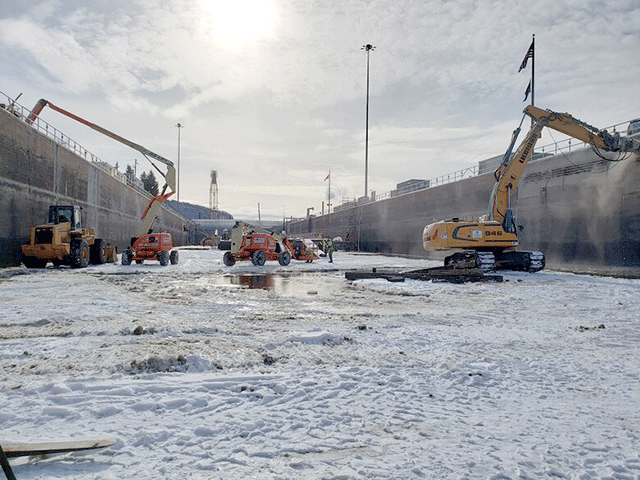Cash Market Moves
USACE Continues Ongoing Repairs, Maintenance on Aging Locks and Dams
The American Society of Civil Engineers' 2021 infrastructure report card released in March graded the nation's inland navigation system a "D-plus." That grade was a slight improvement from the prior "D" with the 2021 higher grade reflecting the "reversal of chronic under-investment in the inland waterways, more purposeful and efficient planning by the U.S. Army Corps of Engineers, the 2014 increase in the diesel fuel tax, and higher operations and maintenance funding that has resulted in a reduction of unscheduled lock outages," said ASCE.
The ASCE report said the waterway infrastructure "includes locks and dams as well as navigation channels" and added that shipping delays cost up to $739 per hour for an average tow within the United States.
President Joe Biden's infrastructure plan would dedicate $17 billion to improve waterways and ports. A Senate Republican counteroffer also proposes spending billions to upgrade waterways. Efforts to advance legislation that both parties can agree on continues in Washington. In the meantime, the Corps continues to repair and maintain the locks and dams on the U.S. river system, and in some cases, those repairs are a temporary fix to keep them operating safely.
Patrick Moes, U.S. Army Corps of Engineers, St. Paul District, in his April 2021 story "A Winter to Remember: Corps of Engineers continues annual winter maintenance fight to preserve aging infrastructure" noted that, according to the Waterways Council Inc. 2020 annual report, approximately 9,700 tows with 55,000 barges were delayed by an average of 12.23 hours across the entire inland navigation system in 2020. The delays resulted in an estimated cost to the economy of nearly $84 million. By comparison, unprecedented high water nationwide in 2019 delayed more than 18,000 tows with more than 60,000 barges. The delays resulted in an estimated economic impact of nearly $166 million, according to the report.
P[L1] D[0x0] M[300x250] OOP[F] ADUNIT[] T[]
While delays can be costly, the inland navigation system is still a reliable, cost-effective mode of transportation that is also the safest, most fuel-efficient and most environmentally friendly. Shipping bulk commodities such as cement, coal, fertilizer, soybeans and corn on the Upper Mississippi River is a simple decision for many producers -- it saves money, Moes noted.
In Minnesota, corn production is credited with contributing $160 million in economic output, according to a 2019 U.S. Department of Agriculture report titled "The Importance of Inland Waterways to U.S. Agriculture." The analysis found that increased investment in the inland waterways system would allow for the transportation of increased volumes of commodities with farm products growing from 14% of commodity volumes on the system in 2016 to 25% by 2029 and 29% by 2045. (https://www.ams.usda.gov/…)
Bryan Peterson, St. Paul District navigation business line manager, said agriculture producers save around $1 per bushel when shipping their corn and soybeans via the river compared to other transportation modes such as trains or trucks. He added that shippers saved around $400 million in 2020 just within the St. Paul District. According to the USDA report, it's estimated that farm products moved via barge save farmers anywhere between $7 billion and $9 billion annually. This includes commodities shipped on the Upper Mississippi River.
"Waterways infrastructure continues to provide economic savings as well as security to the Upper Midwest but requires additional maintenance to ensure it continues performing as it was designed in the 1930s," said Peterson. Recognizing the importance of continued maintenance and eyeing an opportunity to fight back against Mother Nature, Peterson said Corps staff and contractors up and down the Upper Mississippi River galvanized together this past winter to complete more than a dozen major maintenance projects on the locks and dams. He said he is proud that the team worked tirelessly to get the projects finished in time for the start of the 2021 Upper Mississippi River navigation season.
"The repairs varied in size and scope," said Peterson. Moes noted that, in the St. Paul District, Corps staff focused their efforts on replacing miter gate anchorages at Lock and Dam 2 near Hastings, Minnesota; straightening miter gates at Lock and Dam 3 near Red Wing, Minnesota; dewatering Lock and Dam 4 near Alma, Wisconsin, for major maintenance repairs that occur approximately every 20 years; and upgrading tow rails at Lock and Dam 5 near Minnesota City, Minnesota, and Lock and Dam 5A, near Fountain City, Wisconsin. The tow rail upgrades assist upbound tows to safely maneuver through the lock.
Despite the many hours worked and repairs completed this past winter, Peterson said he knows the job is far from complete, with more work to be done to sustain the reliable system our partners depend upon. "We will continue to address the highest priority projects within the Mississippi Valley Division through the prioritization of maintenance process to assure the limited funding goes toward the projects that represent the highest risk to the system," he said.
Mary Kennedy can be reached at mary.kennedy@dtn.com
Follow her on Twitter @MaryCKenn
(c) Copyright 2021 DTN, LLC. All rights reserved.




